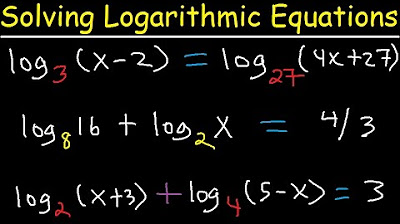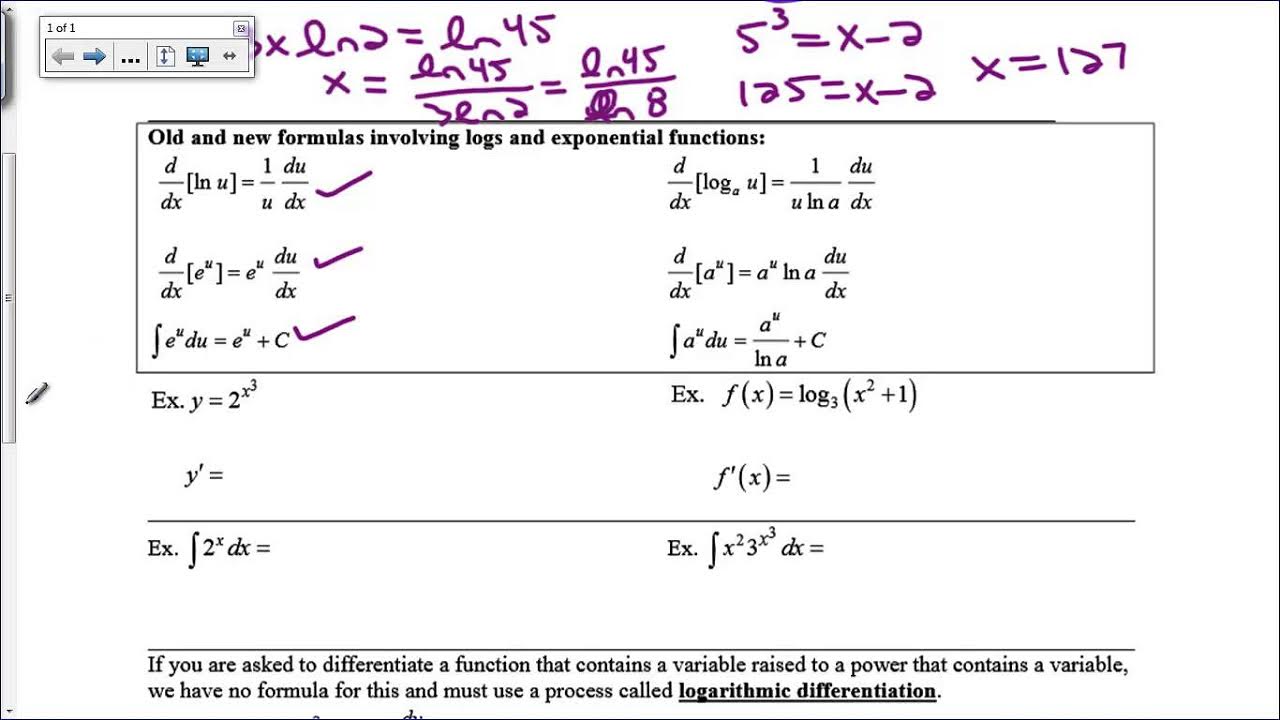Ch. 4.4 Laws of Logarithms
TLDRThis educational video script delves into the laws of logarithms, drawing parallels with the rules of exponents to simplify understanding. It covers fundamental logarithmic rules, including the addition of logarithms for multiplication, subtraction for division, and the transformation of exponents into scalar multiples. The script illustrates these concepts with examples, emphasizing the importance of Rule 3 for frequent use. It also introduces the change of base formula, demonstrating its utility in solving logarithmic equations, especially when dealing with unfamiliar bases, by leveraging standard logarithms available on calculators.
Takeaways
- 📚 The class is discussing Chapter 4.4, focusing on the laws of logarithms and their relation to exponential functions.
- 🔑 The instructor finds that understanding logarithmic rules becomes easier by drawing parallels to the rules of exponents.
- ✅ Logarithms can be simplified using three main rules: addition for multiplication, subtraction for division, and moving the exponent outside as a multiplier.
- 🔍 The multiplication rule for logarithms states that log_b(mn) is equivalent to log_b(m) + log_b(n).
- 🔎 The division rule for logarithms is that log_b(m/n) is equivalent to log_b(m) - log_b(n).
- 📈 The power rule, log_b(m^p), is crucial and states that the exponent p can be brought outside the logarithm as a multiplier.
- 📉 Special logarithmic values are highlighted, such as log_b(b) being equal to 1 and log_b(1) being equal to 0.
- 🧩 The process of combining multiple logarithmic expressions into a single logarithm is demonstrated, emphasizing the need for the same base.
- 📝 An example is provided to show how to expand a complex logarithmic expression using the logarithmic rules.
- 🔄 The concept of change of base formula is introduced, allowing for the conversion between different logarithmic bases.
- 🛠 The importance of using standard logarithmic bases like base 10 or natural logarithms for ease of calculation with calculators is emphasized.
Q & A
What is the main topic of Chapter 4.4 discussed in the transcript?
-The main topic of Chapter 4.4 is the laws of logarithms and how they relate to exponential functions, including how to use these laws to solve logarithmic equations.
Why did the instructor find the rules of logarithms confusing at first?
-The instructor found the rules of logarithms confusing at first because they were not aware that these rules are essentially the same as the rules of exponents.
How does the instructor suggest simplifying log(b)(m * n)?
-The instructor suggests simplifying log(b)(m * n) by separating it into two different logarithms that are added together, which is analogous to multiplying powers with the same base.
What is the logarithmic equivalent of multiplying powers with the same base?
-The logarithmic equivalent of multiplying powers with the same base is to add the exponents, as shown by the rule log_b(m * n) = log_b(m) + log_b(n).
How does the rule for log base b of m over n relate to the rules of exponents?
-The rule for log base b of m over n is analogous to subtracting the exponents when you have b to the power of m divided by b to the power of n, which simplifies to log_b(m) - log_b(n).
What is the most important rule of logarithms according to the instructor?
-The most important rule of logarithms, according to the instructor, is the power rule, which states that log_b(m^p) = p * log_b(m).
What happens when you have a logarithm with the base raised to the power of the logarithm, such as log_b(b)?
-When you have a logarithm with the base raised to the power of the logarithm, such as log_b(b), the result is 1, as the base and the argument cancel each other out.
Why is it incorrect to combine logs with different bases into a single logarithm by simply adding them together?
-It is incorrect to combine logs with different bases into a single logarithm by simply adding them together because the rules of logarithms require that all terms in a logarithmic expression must have the same base before they can be combined.
What is the change of base formula and how does it relate to solving exponential equations?
-The change of base formula allows you to rewrite a logarithm with an unfamiliar base into one with a base that is easier to work with, such as base 10 or the natural log. It is derived from taking the log of both sides of an equation and simplifying, leading to the formula log_b(y) = log_a(y) / log_a(b).
Why might a student make the mistake of expanding a logarithm with a plus sign inside?
-A student might make the mistake of expanding a logarithm with a plus sign inside because they might incorrectly assume that the logarithmic rules apply to addition and subtraction inside the logarithm, when in fact, they only apply to multiplication, division, and exponentiation.
How can the change of base formula be used to find the value of log base 3 of 16 without using a calculator?
-The change of base formula can be used to find the value of log base 3 of 16 by rewriting it as log base 10 of 16 divided by log base 10 of 3, or as natural log of 16 divided by natural log of 3, which can then be calculated using a calculator that supports base 10 or natural logarithms.
Outlines
📚 Introduction to Logarithm Laws
The script begins with an introduction to Chapter 4.4, focusing on the laws of logarithms. The instructor aims to clarify the rules governing logarithms and their relationship with exponential functions. It is emphasized that understanding these laws is crucial for solving logarithmic equations. The instructor shares a personal anecdote about how recognizing the similarity between the rules of logarithms and exponents made the concepts easier to grasp and remember. The summary includes a discussion of how multiplication within logarithms translates to addition, and vice versa, when dealing with exponents.
🔍 Applying Logarithm Rules for Problem Solving
This paragraph delves into the application of logarithm rules to solve equations. The instructor illustrates how to combine multiple logarithmic expressions into a single logarithm by ensuring they share the same base. The explanation covers the process of applying the logarithm power rule (rule three), which allows the exponent to become a multiplier outside the logarithm. The paragraph also addresses common mistakes students make when attempting to expand logarithmic expressions and emphasizes the importance of correctly applying logarithm rules to avoid such errors.
🔄 Change of Base Formula and Logarithm Expansion
The final paragraph introduces the concept of the change of base formula, which is a valuable tool for simplifying logarithmic expressions, especially when dealing with unfamiliar bases. The instructor demonstrates how to use the change of base formula by converting a logarithm with an unfamiliar base into one with a more familiar base, such as the natural log or the common log (base 10). This allows for easier calculation using a calculator. The explanation includes an example of converting log base 3 of 16 into a form that can be computed using a standard calculator, showcasing the practicality of the change of base formula in solving logarithmic problems.
Mindmap
Keywords
💡Logarithms
💡Exponential Functions
💡Logarithmic Equations
💡Rules of Logarithms
💡Product Rule
💡Quotient Rule
💡Power Rule
💡Change of Base Formula
💡Natural Logarithm
💡Logarithmic Expansion
💡Logarithmic Simplification
Highlights
Introduction to Chapter 4.4 focusing on the laws of logarithms and their relation to exponential functions.
The speaker finds the rules of logarithms easier to remember by relating them to the rules of exponents.
Logarithm of a product rule: converting multiplication inside a logarithm into addition of logarithms.
Logarithm of a quotient rule: converting division inside a logarithm into subtraction of logarithms.
Power rule for logarithms: moving the exponent outside the logarithm as a multiplier.
The power rule is identified as the most important and frequently used logarithm rule.
Special logarithm cases: log base b of 1 equals zero, and a base raised to its logarithm equals the argument.
Combining logarithms with the same base using logarithm rules to simplify expressions.
Clarification that logarithms with different bases cannot be directly added together.
Expanding logarithmic expressions using the rules of logarithms to break them into simpler components.
Mistake clarification: you cannot split a sum inside a logarithm using logarithm rules.
Using logarithms to solve exponential equations by taking the logarithm of both sides.
Demonstration of the change of base formula derived from logarithm rules.
Practical application of the change of base formula to find the value of logarithms that calculators cannot directly compute.
Advantages of using standard logarithms (base 10 or natural log) due to calculator compatibility.
Example calculation using the change of base formula with base 10 logarithms.
Example calculation using the change of base formula with natural logarithms.
Transcripts
Browse More Related Video

How to Combine Logarithms (Precalculus - College Algebra 60)

Using Logarithms and Natural Logarithms in Chemistry

Business Calculus -- Math 1329 -- Section 4.2 -- Logarithmic Functions

Solving Logarithmic Equations With Different Bases - Algebra 2 & Precalculus

How to Expand Logarithms (Precalculus - College Algebra 59)

Bases other than e
5.0 / 5 (0 votes)
Thanks for rating: